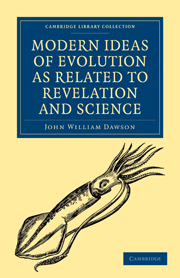Book contents
- Frontmatter
- PREFACE
- Contents
- CHAPTER I PRESENT ASPECTS OF THE QUESTION
- CHAPTER II WHAT IS EVOLUTION?
- CHAPTER III THE ORIGIN OF LIFE
- CHAPTER IV THE APPARITION OF SPECIES IN GEOLOGICAL TIME
- CHAPTER V MONISTIC EVOLUTION
- CHAPTER VI AGNOSTIC EVOLUTION
- CHAPTER VII THEISTIC EVOLUTION
- CHAPTER VIII GOD IN NATURE
- CHAPTER IX MAN IN NATURE
- CHAPTER X GENERAL CONCLUSIONS
- APPENDIX I WEISMANN ON HEREDITY
- APPENDIX II DR. McCOSH ON EVOLUTION
APPENDIX I - WEISMANN ON HEREDITY
Published online by Cambridge University Press: 29 August 2010
- Frontmatter
- PREFACE
- Contents
- CHAPTER I PRESENT ASPECTS OF THE QUESTION
- CHAPTER II WHAT IS EVOLUTION?
- CHAPTER III THE ORIGIN OF LIFE
- CHAPTER IV THE APPARITION OF SPECIES IN GEOLOGICAL TIME
- CHAPTER V MONISTIC EVOLUTION
- CHAPTER VI AGNOSTIC EVOLUTION
- CHAPTER VII THEISTIC EVOLUTION
- CHAPTER VIII GOD IN NATURE
- CHAPTER IX MAN IN NATURE
- CHAPTER X GENERAL CONCLUSIONS
- APPENDIX I WEISMANN ON HEREDITY
- APPENDIX II DR. McCOSH ON EVOLUTION
Summary
The new views advanced by Weismann have, while these pages were going through the press, been subjects of warm discussion in England, where his essays have been translated and republished; but the subject has been so beclouded with technicalities and references to obscure facts of reproduction, that it is scarcely intelligible to non-technical readers. An explanation of the actual nature and bearing of these views may therefore be useful.
The subject may be regarded from the point of view either (1) of the facts of reproduction, or (2) of observed phenomena of inheritance.
1. With reference to the first of these, nothing is more certain than that in all animals, except a few of the lowest, there are special organs of reproduction, and that in these organs alone resides the power of permanent continuance of the species. The facts of budding and spontaneous division in some animals of low grade may be regarded as of only temporary importance. Farther, the organ of reproduction resolves itself into a single microscopic embryo cell or germ, a minute vesicle containing protoplasmic matter, fertilised by another or sperm-cell, and finally into the speck of protoplasm constituting the nucleus of this embryo cell. This minute living speck must contain in it potentially all the parts and organs that are produced from it. Weismann illustrates this in a clear manner by the observed fact of the spontaneous division of this nucleus into a vast number of separate granules, each of which plays a part in the formation of some portion of the embryo animal.
Information
- Type
- Chapter
- Information
- Modern Ideas of Evolution as Related to Revelation and Science , pp. 235 - 239Publisher: Cambridge University PressPrint publication year: 2009First published in: 1890
